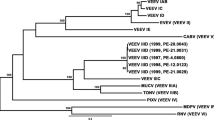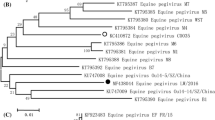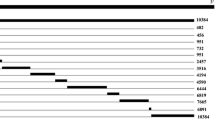Abstract
Caprine arthritis encephalitis virus (CAEV) causes caprine arthritis encephalitis syndrome, which is an emerging disease of goats in the Philippines. DNA sequence analysis showed homology of 86–93 % between Philippine CAEV and available CAEV sequences in GenBank. CAEV was detected using nested polymerase chain reaction (PCR), and new sets of primers were designed in order to amplify the gag gene, which is a highly conserved region of the viral genome. In addition, the Philippine CAEV isolate clustered in group B with the prototype caprine lentivirus. Based on amino acid sequence alignments, it is possible that the Philippine CAEV isolate is a new strain of CAEV, but it is also possible that it was already present in the country even before the start of goat importation. Molecular characterization of the CAEV gag gene is important for the development of a detection kit specific for the local strain of CAEV and the establishment of small ruminant lentivirus eradication programs in the Philippines. This study is the first report to describe the molecular characteristics of CAEV circulating in the Philippines.






Similar content being viewed by others
References
Gendelman HE, Narayan O, Molineaux S, Clements JE, Ghotbi Z (1985) Slow, persistent replication of lentiviruses: role of tissue macrophages and macrophage precursors in bone marrow. Proc Natl Acad Sci USA 82(20):7086–7090
De Boer GF, Terpstra C, Houwers DJ, Hendricks J (1979) Studies in epidemiology of maedi/visna in sheep. Res Vet Sci 26(2):202–208
Greenwood PL, North RN, Kirkland PD (1995) Prevalence, spread and control of caprine arthritis-encephalitis virus in dairy goat herds in New South Wales. Aust Vet J 72(9):341–345
Santry LA, De Jong J, Gold AC, Walsh SR, Menzies PI, Wootton SK (2013) Genetic characterization of small ruminant lentiviruses circulating in naturally infected sheep and goats in Ontario, Canada. Virus Res 175(1):30–44
Blacklaws BA, Berriatua E, Torsteinsdottir S, Watt NJ, de Andres D, Klein D, Harkiss GD (2004) Transmission of small ruminant lentiviruses. Vet Microbiol 101(3):199–208
Turelli P, Guiguen F, Mornex JF, Vigne R, Quérat G (1997) dUTPase-minus caprine arthritis-encephalitis virus is attenuated for pathogenesis and accumulates G-to-A substitutions. J Virol 71(6):4522
Saltarelli M, Querat G, Konings DA, Vigne R, Clements J (1990) Nucleotide sequences and transcriptional analysis of molecular clones of CAEV which generates infectious virus. Virology 179:347–364
Castro RS, Greenland T, Leite RC, Gouveia A, Mornex JF, Cordier G (1999) Conserved sequence motifs involving the tat reading frame of Brazilian caprine lentiviruses indicate affiliations to both caprine-arthritis encephalitis virus and visna-maedi virus. J Gen Virol 80(Pt 7):1583–1589
Karr BM, Chebloune Y, Leung K, Narayan O (1996) Genetic characterization of two phenotypically distinct North American ovine lentiviruses and their possible origin from caprine arthritis-encephalitis virus. Virology 225(1):1–10
Kaba J, Rola M, Materniak M, Kuzmak J, Nowicki M (2009) Isolation and characterization of caprine arthritis encephalitis virus in goats from Poland. Pol J Vet Sci 12(2):183–188
Shah C, Huder JB, Boni J, Schonmann M, Muhlherr J, Lutz H, Schupbach J (2004) Direct evidence for natural transmission of small ruminant lentiviruses of subtype A4 from goats to sheep and vice versa. J Virol 78(14):7518–7522
Zanoni RG (1998) Phylogenetic analysis of small ruminant lentiviruses. J Gen Virol 79(Pt 8):1951–1961
Peterhans E, Greenland T, Badiola J, Harkiss J, Bertoni G, Amorena B, Eliaszewicz M, Juste RA, Krassnig R, Lafont JP, Lenihan P, Petursson G, Pritchard G, Thorley J, Vitu C, Mornex JF, Pepin M (2004) Routes of transmission and consequences of small ruminant lentiviruses (SRLVs) infection and eradication schemes. Vet Res 35(3):257–274
Contreras A, Corrales JC, Sanchez A, Aduriz JJ, Gonzalez L, Marco J (1998) Caprine arthritis-encephalitis in an indigenous Spanish breed of dairy goats. Vet Rec 142:140–142
Al-Qudah K, Al-Majali AM, Ismail ZB (2006) Epidemiological studies on caprine arthritis-encephalitis virus infection in Jordan. Small Rumin Res 66:181–186
Leitner G, Krifucks O, Weisblit L, Lavi Y, Bernstein S, MerinLerondelle U (2010) The effect of caprine arthritis encephalitis virus infection on production in goats. Vet J 183:328–331
Leitner G, Merin U, Silanikove N (2004) Changes in milk composition as affected by subclinical mastitis in goats. J Dairy Sci 87:1719–1726
Smith MC, Cutlip R (1998) Effects of infection with caprine arthritis-encephalitis virus on milk production in goats. J Am Vet Med Assoc 193:63–67
Bergonier D, De Cremoux R, Rupp R, Lagriffoul G, Berthelot X (2003) Mastitis of dairy small ruminants. Vet Res 34:689–716
Malher X, Seegers H, Beaudeau F (2001) Culling and mortality in large dairy goat herds managed under intensive conditions in western France. Livestock Prod Sci 71:75–86
Bondoc OL (2005) Philippine Goat Breed Registry in relation to genetic improvement and conservation. Philippine Agric Sci 88(2):179–191
Goat Industry Performance Report. Bureau of Agricultural Statistics 2014
Lluz A, Orais A, Dumilon R, Orais A, Cerbito W (2011) First detection of caprine arthritis encephalitis infection in goats using ELISA test in eastern Visayas, Philippines. J Vet Anim Sci 37(2):159–166
Gonzales JVC, Domingo CYJ, Abes NS, Gutierrez CA, Villanueva MA, Mingala CN (2013) Concordance of competitive enzyme linked immunosorbent assay and nested-polymerase chain reaction in the detection of caprine arthritis-encephalitis virus. Small Rumin Res 115:134–139
DA-AO 17. Department of Agriculture Administrative Order No. 17, Series of 2004. Philippines
BAI (2004) Handbook on diagnostic laboratory data 2004. Philippine Animal Health Center, Bureau of Animal Industry, Department of Agriculture
Huang J, Sun Y, Liu Y, **ao H, Zhuang S (2012) Development of loop-mediated isothermal amplification method for rapid detection of caprine arthritis encephalitis virus proviral DNA. Arch Virol 157(8):1463–1469
Tajima S, Ikawa Y, Aida Y (1998) Complete bovine leukemia virus (BLV) provirus is conserved in BLV-infected cattle throughout the course of B-cell lymphosarcoma development. J Virol 113:55–56
Konishi M, Tsuduku S, Haritani M, Murakami K, Tsuboi T, Kobayashi C, Yoshikawa K, Kimura K, Sentsui H (2004) An epidemic of caprine arthritis encephalitis in Japan: isolation of the virus. J Vet Med Sci 66(8):911–917
Tamura K, Peterson D, Peterson N, Stecher G, Nei M, Kumar S (2011) MEGA 5: molecular evolutionary genetics analysis using maximum likelihood, evolutionary distance, and maximum parsimony methods. Mol Biol Evol 28(10):4673–4680
L’Homme Y, Ouardani M, Levesque V, Bertoni G, Simard C, Pisoni G (2011) Molecular characterization and phylogenetic analysis of small ruminant lentiviruses isolated from Canadian sheep and goats. Virol J 8:271
Cork LC, Hadlow WJ, Crawford TB, Gorham JR, Piper RC (1974) Infectious leukoencephalomyelitis of young goats. J Infect Dis 129(2):134–141
Gjerset B, Storset AK, Rimstad E (2006) Genetic diversity of small ruminant lentiviruses: characterization of Norwegian isolates of caprine arthritis encephalitis virus. J Gen Virol 87(Pt3):573–580
Pisoni G, Quasso A, Moroni P (2005) Phylogenetic analysis of small-ruminant lentivirus subtype B1 in mixed flocks: evidence for natural transmission from goats to sheep. Virology 339(2):147–152
Leroux C, Chatang J, Greenland T, Mornex JF (1997) Genomic heterogeneity of small ruminant lentiviruses: existence of heterogenous population in sheep and of the same lentiviral genotypes in sheep and goats. Arch Virol 142(6):1125–1137
Pisoni G, Bertoni G, Puricelli M, Macalli M, Moroni P (2007) Demonstration of coinfection with the recombination by caprine arthritis encephalitis virus and maedi-visna virus in naturally infected goats. J Virol 81(10):4948–4955
Zhang L, Diaz RS, Ho DD, Mosley JW, Busch MP, Mayer A (1997) Host specific driving force in human immunodeficiency virus type 1 evolution in vivo. J Virol 71(3):2555–2561
Conteras A, Corrales JC, Sanchez A, Sierra D (1997) Persistence of subclinical intramammary pathogens in goats throughout lactation. J Dairy Sci 80(11):2815–2819
Pisoni G, Bertoni G, Boettcher P, Ponti W, Moroni P (2006) Phylogenetic analysis of the gag region encoding the matrix protein of small ruminant lentiviruses: comparative analysis and molecular epidemiological applications. Virus Res 116(1–2):159–167
Gil A, Rola M, Kuzmak J (2006) Application of PCR technique in diagnosis of small ruminant lentivirus infection in sheep and goats. Pol J Vet Sci 9(4):213–217
Leginagoika I, Minguijon E, Berriatua E, Juste RA (2009) Improvements in the detection of small lentivirus infection in the blood of sheep by PCR. J Virol Methods 156(1–2):145–149
Balbin MM, Belotindos LP, Abes NS, Mingala CN (2014) Caprine arthritis encephalitis virus detection in blood by loop-mediated isothermal amplification (LAMP) assay targeting the proviral gag region. Diagn Microbiol Infect Dis 79:37–42
Acknowledgments
We thank Dr. Arnel N. del Barrio, Philippine Carabao Center (PCC) Executive Director, for the support to finish the study. Thanks to the DOST-GIA and DOST-PCAARRD for the research grant and for monitoring the progress of the research, respectively. Also, special thanks to all the staff of the Animal Health Unit of PCC for their technical support.
Author information
Authors and Affiliations
Corresponding author
Additional information
R. B. C. Padiernos and C. N. Mingala contributed equally to this work.
Rights and permissions
About this article
Cite this article
Padiernos, R.B.C., Balbin, M.M., Parayao, A.M. et al. Molecular characterization of the gag gene of caprine arthritis encephalitis virus from goats in the Philippines. Arch Virol 160, 969–978 (2015). https://doi.org/10.1007/s00705-015-2359-5
Received:
Accepted:
Published:
Issue Date:
DOI: https://doi.org/10.1007/s00705-015-2359-5




